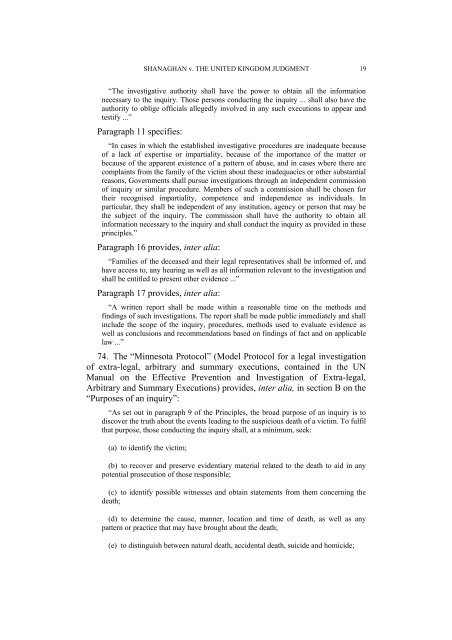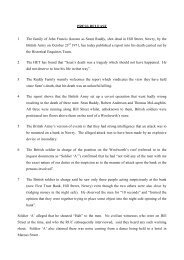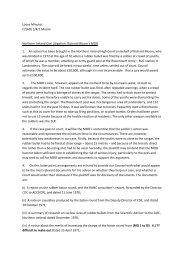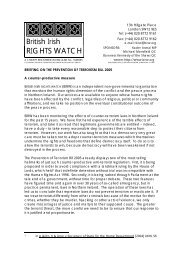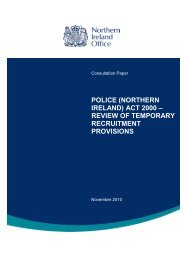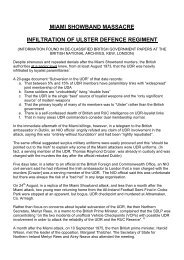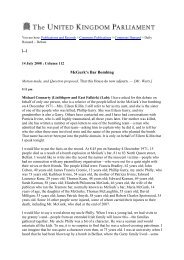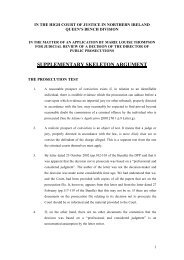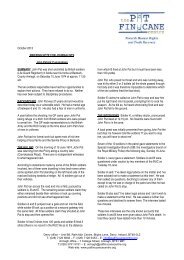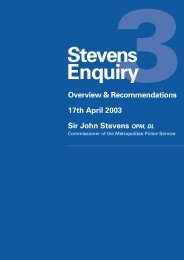Patrick Shanaghan v the United Kingdom - The Pat Finucane Centre
Patrick Shanaghan v the United Kingdom - The Pat Finucane Centre
Patrick Shanaghan v the United Kingdom - The Pat Finucane Centre
Create successful ePaper yourself
Turn your PDF publications into a flip-book with our unique Google optimized e-Paper software.
SHANAGHAN v. THE UNITED KINGDOM JUDGMENT 19<br />
“<strong>The</strong> investigative authority shall have <strong>the</strong> power to obtain all <strong>the</strong> information<br />
necessary to <strong>the</strong> inquiry. Those persons conducting <strong>the</strong> inquiry ... shall also have <strong>the</strong><br />
authority to oblige officials allegedly involved in any such executions to appear and<br />
testify ...”<br />
Paragraph 11 specifies:<br />
“In cases in which <strong>the</strong> established investigative procedures are inadequate because<br />
of a lack of expertise or impartiality, because of <strong>the</strong> importance of <strong>the</strong> matter or<br />
because of <strong>the</strong> apparent existence of a pattern of abuse, and in cases where <strong>the</strong>re are<br />
complaints from <strong>the</strong> family of <strong>the</strong> victim about <strong>the</strong>se inadequacies or o<strong>the</strong>r substantial<br />
reasons, Governments shall pursue investigations through an independent commission<br />
of inquiry or similar procedure. Members of such a commission shall be chosen for<br />
<strong>the</strong>ir recognised impartiality, competence and independence as individuals. In<br />
particular, <strong>the</strong>y shall be independent of any institution, agency or person that may be<br />
<strong>the</strong> subject of <strong>the</strong> inquiry. <strong>The</strong> commission shall have <strong>the</strong> authority to obtain all<br />
information necessary to <strong>the</strong> inquiry and shall conduct <strong>the</strong> inquiry as provided in <strong>the</strong>se<br />
principles.”<br />
Paragraph 16 provides, inter alia:<br />
“Families of <strong>the</strong> deceased and <strong>the</strong>ir legal representatives shall be informed of, and<br />
have access to, any hearing as well as all information relevant to <strong>the</strong> investigation and<br />
shall be entitled to present o<strong>the</strong>r evidence ...”<br />
Paragraph 17 provides, inter alia:<br />
“A written report shall be made within a reasonable time on <strong>the</strong> methods and<br />
findings of such investigations. <strong>The</strong> report shall be made public immediately and shall<br />
include <strong>the</strong> scope of <strong>the</strong> inquiry, procedures, methods used to evaluate evidence as<br />
well as conclusions and recommendations based on findings of fact and on applicable<br />
law ...”<br />
74. <strong>The</strong> “Minnesota Protocol” (Model Protocol for a legal investigation<br />
of extra-legal, arbitrary and summary executions, contained in <strong>the</strong> UN<br />
Manual on <strong>the</strong> Effective Prevention and Investigation of Extra-legal,<br />
Arbitrary and Summary Executions) provides, inter alia, in section B on <strong>the</strong><br />
“Purposes of an inquiry”:<br />
“As set out in paragraph 9 of <strong>the</strong> Principles, <strong>the</strong> broad purpose of an inquiry is to<br />
discover <strong>the</strong> truth about <strong>the</strong> events leading to <strong>the</strong> suspicious death of a victim. To fulfil<br />
that purpose, those conducting <strong>the</strong> inquiry shall, at a minimum, seek:<br />
(a) to identify <strong>the</strong> victim;<br />
(b) to recover and preserve evidentiary material related to <strong>the</strong> death to aid in any<br />
potential prosecution of those responsible;<br />
(c) to identify possible witnesses and obtain statements from <strong>the</strong>m concerning <strong>the</strong><br />
death;<br />
(d) to determine <strong>the</strong> cause, manner, location and time of death, as well as any<br />
pattern or practice that may have brought about <strong>the</strong> death;<br />
(e) to distinguish between natural death, accidental death, suicide and homicide;


